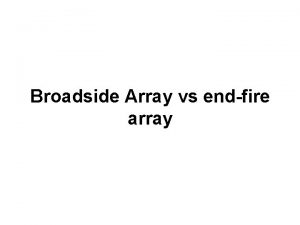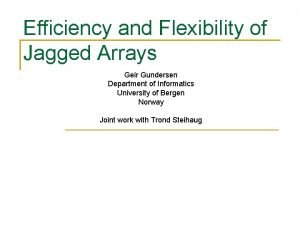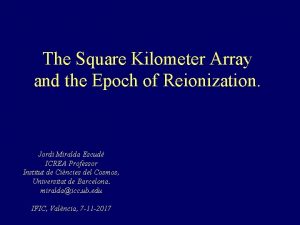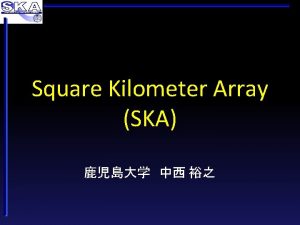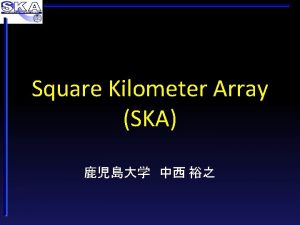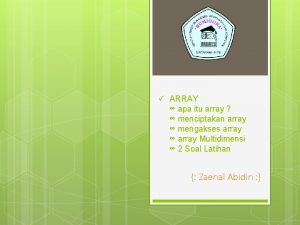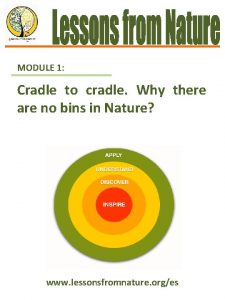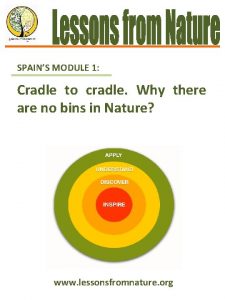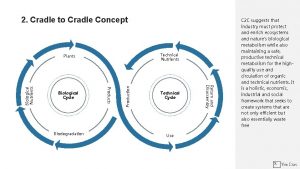The Square Kilometer Array and the Cradle of


















- Slides: 18

The Square Kilometer Array and the “Cradle of Life” David Wilner (Cf. A) October 27, 2006 US SKA, Cf. A 1

The Cradle of Life • A Key Science Project – image dust emission from terrestrial planet formation zone of protoplanetary disks – assess biomolecules in ISM and disks – reach qualitatively new levels of sensitivity for SETI, including possible detection of “leakage” emissions (next talk, Jill Tarter) 2

Protoplanetary Disks • T Tauri, Herbig Ae stars: several l 00’s of proto-Sun analogs, d ~ 140 pc, age 1 -10 Myr 1. 3 mm SMA Raman et al. 2006 star dust HD 169142 Dent et al. 2006 300 AU HST Grady et al. 2006 3

Planet Formation • How do terrestrial and giant planets form? • How much orbital evolution (migration)? • Is our Solar System architecture typical? • SKA uniquely accesses disk habitable zone – need cm waves: avoid high opacity – need milli-arcsec resolution: sub-AU at 140 pc – need very high sensitivity: thermal emission 4

SKA Sensitivity • flux density emitted by a disk element d. A • less than an Earth mass in sub-AU beam at 140 pc distance of nearby dark clouds 5

Grain Growth and Settling • detailed frequency dependence of dust emissivity is diagnostic of particle properties, esp. size • SKA sensitive to cm sizes, predicted to settle to disk mid-plane and seed planetesimals TW Hya 3. 5 cm dust Wilner et al NASA/JPL R. Hurt . 6

Embedded Protoplanets • protoplanet interacts tidally with disk – transfers angular mom. – opens gap – viscosity opposes r Bate et al. P. Armitage 7

Small Bodies, Large Signatures • Moon (S/2005 S 1) in Keeler Gap, Cassini (May 1, 2005) 8

Inner Disk Holes • • SEDs of some disk systems show mid-ir flux deficits suggest inner holes, radii ~ 20 to 40 AU SMA imaging, 340 GHz, 250 mas, confirms evidence for dynamical sculpting by Jovian protoplanets HD 135344 SR 21 Brown et al. , Wilner et al GM Aur 9

A Dynamic Process • orbital timescales in habitable zone are short (t ~ 1 yr) • synoptic studies track proper motions of mass concentrations • make “movies” of inner disk structure Nelson et al. 10

New Facilities, New Territory ? 10 AU 100 AU SMA today ALMA 2013? 1 AU SKA 2020? 11

Biomolecules • Universal prebioitic chemistry? • Delivery to terrestrial planet zone? • SKA uniquely accesses low excitation rotational transitions of large molecules – favorable partition function – low line confusion – high sensitivity 12

New Interstellar Molecules • GBT: 8 (secure) new species in past 2 years rich chemistry in dark clouds leading to large organic species Lovas, Hollis, Remijan et al. 13

Protoplanetary Disk Assays • molecules detected in handful of disks – – TW Hya ion-molecule reactions (HCO+) photo-processes (high CN/HCN) deuterium fractionation (DCO+) simple organics (H 2 CO) • sensitivity limited Thi et al. 14

The Cradle of Life • image terrestrial planet formation zone of disks – grain growth to pebbles – embedded protoplanets and sub-AU tidal gaps – track motions Bryden 1999 • assess biomolecules – disk abundances – locations Remijan et al. 2006 15

Philosophical Remark • Future optical/infrared searches may reveal terrestrial exoplanets that can harbor life • Radio observations into the habitable zone of protoplanetary disks will help us to understand why they are there (and why we are here) 16

End 17

Relevance of Radio Regime • bulk of disk material is “cold” (dark!) H 2 – probed only through minor constituents • dust: continuum emission with low opacity – d. Fn = Bn(T) kn d. A, detect every dust particle; millimeter flux ~ mass, weighted by temperature – Mdisk~ 0. 001 - 0. 1 M (Beckwith et al. 1990) • gas: spectral lines of trace species (CO, HCN, . . . ) – heterodyne dn/n >106: kinematics, chemistry • no contrast problem with stellar photosphere • high resolution imaging through interferometry 18
 Sustainability & resource productivity consulting
Sustainability & resource productivity consulting Cradle to grave cradle to gate
Cradle to grave cradle to gate Bedankt
Bedankt Cradle to cradle
Cradle to cradle Pin grid array
Pin grid array Comparison between broadside array and endfire array
Comparison between broadside array and endfire array Latihan soal struktur data pertemuan 4
Latihan soal struktur data pertemuan 4 Jagged array vs multidimensional array
Jagged array vs multidimensional array Associative array vs indexed array
Associative array vs indexed array Latik adalah
Latik adalah Upper triangular array adalah
Upper triangular array adalah Dimension of array python
Dimension of array python Photovoltaic array maximum power point tracking array
Photovoltaic array maximum power point tracking array Whats longer a mile or a kilometer
Whats longer a mile or a kilometer Flocity
Flocity Pada mobil baru angka kilometer
Pada mobil baru angka kilometer Missionsreisen paulus kilometer
Missionsreisen paulus kilometer Omrekenen afstand
Omrekenen afstand The cradle of civilization
The cradle of civilization





